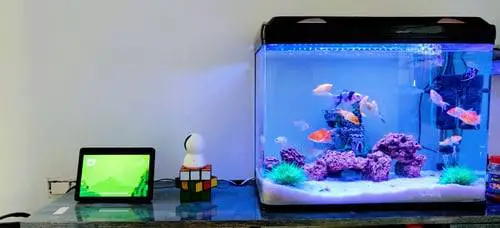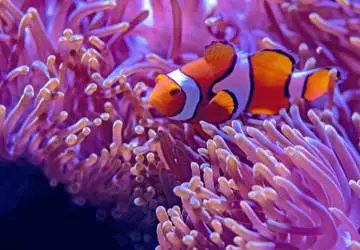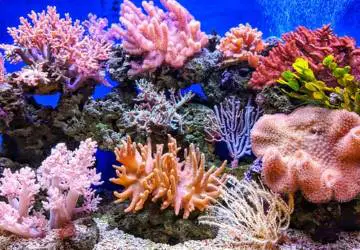Do you want to start a fish tank but don’t know where to start? This article will give you some basic information about the types of fish, their care, and other important considerations.
Which Type of Fish Tank Should You Get for Beginners?

There are a number of different types of fish tanks to choose from, and each has its own benefits and drawbacks.
The three most common types of fish tanks are:
- The classic aquarium with a glass tank and metal frame;
- The acrylic aquarium, which is lighter than glass and less likely to shatter; and
- The plastic aquarium.
Acrylic tanks are by far the most popular with fish keepers – they are lighter, safer, and less likely to crack or shatter than glass tanks. However, they are also more expensive. If you do not have a lot of money to spare at the moment but plan on keeping an aquarium for a long time, then you can always start out with a glass tank – just be extra careful when handling it! Acrylic aquariums are usually about half the price of their metallic counterparts.
Plastic tanks are the cheapest type of fish tank available; however, many people feel that they lack style and do not like their dull grey appearance (although this is often compensated by very low prices).
Because acrylic aquariums are so sturdy and easy to clean, they are by far the most popular with beginners.
What Size Fish Tank Should You Get?
Most experts recommend purchasing a tank that is at least 30 gallons in size for your first aquarium. This allows you plenty of space to stock your tank without having to worry about overcrowding or uneaten fish food rotting away in the water (which can cause dangerous ammonia spikes).
However, for very active fish that require more oxygen (such as goldfish), you will want to get a tank larger than 30 gallons – 50 gallons is usually good enough. A quick guide on how many fish you can keep would be 1 inch of fish per gallon of water – but remember that this doesn’t apply to all types of fish. Goldfish require much more space than this, for example.
It’s important to note that larger tanks are much easier to cycle than smaller ones; however, there are other factors that make it easier or harder. For instance, if you get a large tank but don’t do enough water changes, you could end up with high ammonia and nitrite levels, which will be harmful to your fish (although the same thing applies to small tanks, too – just not quite as quickly).
How to Set up Your Aquarium?
Once you get your tank home, it is important that you set up your new fish tank properly.
The first thing to do is find a good location for your aquarium – low-traffic areas are best. Fish tanks should not be kept in direct sunlight (it will cause the water temperature to rise), nor near heaters or other hot equipment (which increases the chances of the glass cracking).
Do not place your aquarium on top of carpeting – this can lead to moisture build-up and rust over time which may damage the floor underneath the carpet.
Next, you need to take out all the equipment and tools that came with your aquarium package: gravel substrate, filter media, heater, thermometer, and plants (if you’re using them).
It is important to rinse the gravel substrate in a colander before adding it to your tank – this will help get rid of any dust or dirt that may have come with it. If you are not using a filter, then you do not need to worry about this step.
Now it’s time to set up the filter. This process may vary depending on the type of filter you have, so be sure to read the instructions carefully. In most cases, you will need to add some filter media (such as activated carbon) and then fill the rest of the filter housing with water.
Attach the filter to the back of your aquarium and plug it in. Now let the aquarium run for a few hours so that the water can get up to temperature.
The last step is to add your plants (if you’re using them) and decorations. Be sure to leave a little open space at the top of the tank for your fish to swim in and out of.
Now your aquarium is ready for fish! Just be patient and wait until the water has cycled completely before adding any new inhabitants.
Cleaning and Maintaining a Tank for Your Fish.
Is a necessary part of being a responsible fish owner. Fish waste and decaying food can create toxic environments for your fish, so it’s important to clean your tank regularly. Luckily, this doesn’t have to be a difficult process – here are some tips on how to clean an aquarium:
- Start by removing any decorations or plants from the tank.
- Next, use a gravel vacuum to clean the substrate (or dirt) at the bottom of the tank. This can be done by sucking up the water and pulling the gravel vacuum through the substrate, then releasing the vacuum to allow the dirty water to flow back into the tank. Be sure to do this slowly and carefully so you don’t disturb the fish or damage the substrate.
- Now it’s time to clean the sides and top of the tank. You can do this by using a soft cloth or sponge that has been soaked in aquarium water (or a fish-safe cleaning solution). Be sure to avoid getting any cleaning solution into the tank itself.
- Finally, use a net to catch the fish and place them into a temporary holding container while you finish cleaning the tank.
- When you’re done, return the fish to their tank and add fresh water. Be sure to check the pH level and temperature of the new water before adding it to the tank.
Regular maintenance like this will help keep your aquarium healthy and your fish happy!
What to Feed Your Fish?
Feeding your fish will be one of the main responsibilities you have if you take on a new pet. It’s important to give your fish a varied diet that is high in protein.
If you are just starting out, however, it might not be possible to determine exactly how much food your fish need; so instead, decide what types of food they like best and start by feeding them two or three times per day. Once you get used to this schedule, try gradually increasing the amount until you find out what their optimal intake is (be sure not to feed them more than they can eat within about five minutes).
Another good way to learn how much food your fish needs is to watch the size of their feces; if it’s big and poopy, they need more food. As a general rule, most fish will do fine with feeding twice per day.
Common Illnesses in Freshwater Fish.
Most common illnesses are caused by the size of the tank, water quality, and diet. Keep these things in mind when providing for your fish’s health.
- Do not buy a tank that is too small for your fish – this will inevitably lead to poor water quality. Fish should have enough room to swim around without bumping into things or other fish. At least 2 gallons per inch of full-grown adult fish is recommended (so a 10-gallon/40-liter tank would be fine for up to 40 cm/16 inches long). If you want more than one type of fish in an aquarium, make sure they won’t fight because some types of fish will kill others if kept together.
- The pH level and temperature of the water in your tank should be closely monitored and kept at healthy levels. Fish can become very ill if the pH level is off or the temperature is too high or low.
- Feed your fish a balanced diet that includes both live and frozen food items. A varied diet is key to keeping your fish healthy.
- Keep an eye on your fish for any signs of illness, such as clamped fins, protruding scales, cloudy eyes, loss of appetite, and lethargy. If you notice any of these symptoms, seek veterinary help immediately.
How do You Care for Your Fish?
There are many different types of fish to choose from, but most can be described as either cold water or tropical fish. This distinction refers to the temperature requirements of each species – with coldwater fish being those that thrive in a cooler environment and tropical species being those that need a much warmer tank.
Each species has its own unique set of needs when it comes to feeding and housing them, so be sure to research your fish carefully before you bring it home. For example, some fish cannot tolerate changes in water pH levels, while others have very specific dietary needs.
Breeds of Saltwater Fish to Consider if You’re a Beginner.

If you’re just starting out in fish-keeping, perhaps the best way to go is with a few easy-to-keep saltwater breeds. Here are some recommendations:
Bicolor blenny – these fish are about 5 cm/2 inches long and do well when kept in groups of at least six. They eat algae, sponges, tunicates, detritus, diatoms, bacteria, etc., so all you need to provide them is plenty of rocks for hiding places and algae growths.
Bristletooth tetra – this small (3 cm/ 1 inch) colorful fish gets along well with other peaceful species and eats flake food or frozen brine shrimp.
Clownfish – probably the most popular saltwater fish; these little guys do well in captivity and can be fed a variety of food items, including pellets, flakes, frozen brine shrimp, Mysis shrimp, and chopped meat.
Firefish – another small (3 cm/ 1 inch) fish that does well in schools; firefish prefer a diet of live food such as brine shrimp or bloodworms but will also eat flake food.
Royal Gramma – a hardy fish that can tolerate a wide range of water conditions, the Royal Gramma eats mostly algae but will also nibble on flake food.
Yellow Tang – one of the larger saltwater fish at around 15 cm/6 inches long, the yellow tang is a popular choice for aquariums because it eats only algae.
Yellow Watchman Goby – another small fish that does well in groups of five or more, the goby prefers to eat crabs and crustacean flesh but will also graze on microalgae from rocks and glass surfaces.
Zebra Moray Eel – one of the best choices for beginners, zebra eels do not require live food and they rarely bite humans (although you should never put your hand anywhere near their mouths). They can grow up to one meter/three feet long depending on their sex; tanks should be at least two meters/six feet deep as these fish like to burrow into the sand and hide there as well as swim in the open.
Other common saltwater fish for beginners.
Here are some other saltwater breeds you might want to consider if this is your first time keeping fish:
Anthias – these small (4 cm/ 1 inch) colorful fish are very peaceful. They need plenty of rocks and caves to hide in, but they do eat algae so you don’t even need to provide special food for them. They like dim lighting, so make sure the aquarium isn’t exposed to strong sunlight through windows or it will become too hot inside.
Damselfish – these beautiful little fish (2 cm/ 1 inch) are very peaceful and prefer dim lighting, which gives their coloration the best display. They can be kept in pairs or in small groups of five or more depending on the species; make sure they have plenty of rocks for hiding places and soft substrate to keep their delicate fins safe from injury.
Hawkfish – these colorful reef dwellers (7 cm/ 3 inches) get along well with other fish that aren’t aggressive; excellent tankmates include clownfish, cardinalfish, and angelfish. They can be trained to eat from your fingers, but don’t expect them to come out of their hiding places unless you have a really big tank or they’re feeling very bold one day.
Jawfish – these tiny fish (1 cm/ 1 inch) are excellent at keeping algae growth in check while being entertaining to watch as they scoot around on the bottom of the tank picking up small morsels of food thrown in for them. Make sure their rocks have plenty of nooks and crannies where they can hide when threatened by other more aggressive saltwater fish.
Mandarinfish – these brightly colored fish (6 cm/ 2 inches) are usually best kept in schools of six or more and need plenty of hiding places among rocks and coral to feel safe. They eat mostly algae but will also nibble on flakes or pellets.
Neon goby – these little guys (3 cm/ 1 inch) come in a variety of colors and love to hang out in the open, making them perfect for small tanks. They eat a variety of food items, including brine shrimp, bloodworms, and flake food.
Ocellaris clownfish – see above entry under “Breeds of saltwater fish to consider if you’re a beginner.”
Types of Freshwater Fish that are Good for Beginners.
The following types of fish are generally considered good for beginners:
White Cloud Mountain Minnows – easy to care for, peaceful, and inexpensive. The only requirement in terms of equipment is that you get an aquarium light (which most starter kits contain, anyway). They need very little heat or filtration but do appreciate a small airstone in the tank.
Platies – easy to care for and relatively inexpensive, although there is some variance on this depending on which type of platy you get. Some types will get large if they aren’t kept in schools; however, most stay small enough that you can keep a school of them together no matter what size your tank is. They prefer warmer than white clouds and also require an aquarium light.
Zebra Danios – these are also easy to care for and very hardy fish. They do best in groups of six or more and like cool water (around 65 degrees Fahrenheit).
Betta Fish – the Betta is a popular fish for beginners because it is hardy, colorful, and doesn’t require a lot of space. However, they are aggressive towards other fish and should only be kept in single-sex tanks (unless you are wanting to breed them).
There are many other types of fish that can be good for beginners, but the ones listed above are a good place to start. With a little bit of research, you should be able to find the perfect fish for your tank!
Tips for Setting up an Aquarium with Plants and Coral Reefs that are Good for Beginners.

If you’re looking to set up an aquarium with plants and coral reefs, there are a few tips that you should keep in mind.
- Start with a larger tank – when starting out, it’s always best to go with a larger tank. This will give you more room to work with and allow for more fish and plant life.
- Use live plants – plastic plants may be less work, but they don’t look or feel as natural as live plants do. Plus, live plants help to filter the water and provide a hiding place for your fish.
- Get some hardy coral – when choosing coral, go for the hardier varieties. These will be less likely to die off if something goes wrong and will be able to bounce back faster after you do a water change.
- Don’t add everything at once – when creating an aquarium with plants and coral reefs, it’s best not to add everything at once. Buy the live plants and wait a few days or weeks before buying your fish (if you get them from the same location) so you can make sure that the temperature of the water is correct and there are no chemicals in the water that could cause problems for your new pets.
- Plant one type of plant per pot – whenever possible, try to only buy one type of plant per pot rather than multiple types in one pot because it can be difficult to tell which type each plant is when they’re all crammed together like that.
- Research, research, research! – before buying anything for your aquarium, be sure to do your research. Not all plants and coral are compatible with each other, so it’s important to know what you’re getting into before you make any purchases.
Conclusion.
Fish are a great starter pet for anyone who is looking for a low-maintenance animal that they can enjoy from the comfort of their home. With just a little bit of regular maintenance, your fish will be happy and healthy!

Meet Brenda Tillman: your go-to expert in Cognitive Behavioral Therapy! Not only is she a seasoned therapist, but she’s also a passionate mom blogger who never misses a beat. Dive deep into her insightful blogs, backed by her extensive coursework in Parenting Skills, Learning, and Education. Brenda’s heartwarming family – a son, two daughters, and their adorable pets – often take center stage in her writings. From parenting hacks and relationship tips to health & fitness nuggets, Brenda has been enlightening her readers for over half a decade. Stick around, and you’re bound to discover gems from a mom who wears many hats with grace!
Reviewed By: Joanna Perez and Marcella Raskin
Edited By: Lenny Terra
Fact Checked By: Gabrielle J. Smith
Photos Taken or Curated By: Matthew Mansour